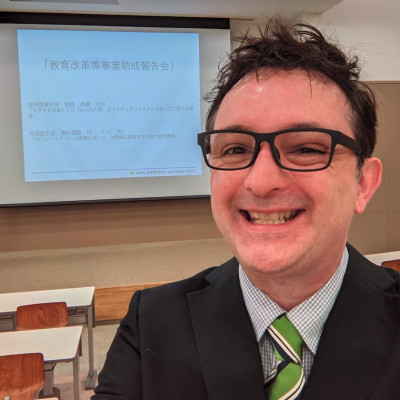Sessions / Zoom 3

Loanwords and Word Guessing: The Impact of a Training Intervention #1267
When reading in a second language (L2), we often come across words that we do not know. At such times, we may guess word meaning by using available information, such as sentence context. We may also notice similarities in form (i.e., spelling and/or the expected pronunciation) with words that we know in our first language (L1). Cognates and loanwords, which typically share some degree of form and meaning across languages, may be particularly helpful for guessing unknown L2 word meanings. However, it has been reported that learners often fail to notice cross-linguistic similarities and thus fail to take advantage of them during inferencing. The present study investigated whether a brief training intervention, which raises awareness of Japanese loanwords derived from English (e.g., イルミネーション / irumineeshon/ ‘illumination’), can improve word guessing accuracy. Initial findings from a study with Japanese learners of English reveal small but significant increases in guessing accuracy for unknown English words that have loanwords in Japanese. This presentation will describe the research design, preliminary findings, and implications of the ongoing study.


Developing a Scale to Measure Foreign Language Presentation Anxiety #1264
Whether their purpose is to present research findings or to prepare themselves for the global workforce after they graduate, being able to carry out an effective presentation can be of great importance for university students. However, one of the greatest inhibitors to a successful presentation is anxiety. While much research has been conducted into measuring and analyzing foreign language anxiety and public speaking anxiety, little research has been conducted on measuring the anxiety foreign-language learners experience conducting presentations. This presentation will detail the development of a Presenting in a Foreign Language Anxiety Scale (PFLAS) specifically designed to measure the anxiety Japanese university students experience when making presentations in English. It is hoped that the information gleaned from this survey will allow the researchers to better understand what aspects of classroom instruction increase or reduce anxiety. This will in turn lead to changes in instruction, to help students become more successful presenters.

Introducing an online application for estimation plots in a New Statistics framework #1284
A common step in quantitative research into language learning is the reliance on null-hypothesis statistical significance testing (NHST) to show the effectiveness or otherwise of different treatments for groups. However, as has been well-documented, multiple problems exist with this approach (see: The American Statistician, 2019, Volume 73, sup1). To move beyond the limitations of NHST, Cumming (2012, 2014) introduces the concept of the New Statistics. Here, the focus shifts from reporting p-values to estimation of effect sizes and confidence intervals (CIs) as a way to better explain what a difference between groups may mean. To help facilitate a New Statistics approach, Ho, et al (2019) have developed a computer package, DABEST, for the creation of estimation graphics. These are data-rich plots which display effect sizes and CIs alongside graphical distribution of all data points from samples. In this presentation, following an overview of the issues above, I will introduce an online application for quantitative data analysis using DABEST. The application, built by the presenter, generates estimation plots and other essential statistical data to help researchers understand results from their research through a New Statistics framework, as well as providing output for use in presentations or publications.

Attachment Styles and their Application to the Language Classroom #1353
Teachers are fundamental agents of change in bringing emotion into the classroom. Attending to the emotional life of the classroom learning community fosters closer connections between teacher and students. In turn, closer connections support a calm and safe environment where optimal learning conditions are formed through the development of emotional intelligence. Optimal conditions are when teachers and learners develop a relationship (attachment style) that is both secure and healthy (Cozolino, 2014). Teachers are able to achieve this by supplying models of behavior, promoting harmony, and helping form habits of excellence with learners. This presentation then will focus on these three points that draw on the theory of attachment styles (Bowlby. 1988). We will explore how teachers can use physical imitation, emotional attunement (mirroring), emotional contagion, and take note of attitude in the classroom. The presenter will offer suggestions for practical action and activity in the classroom that nurtures a secure attachment style.

Revitalizing Student Motivation through Gratitude Intervention #1251
This study reports on how a gratitude-centered intervention helped to raise students’ motivation to study English between 2019 and 2020, amidst a climate of global uncertainty brought about by the COVID-19 pandemic. The research involved ongoing observation of weekly Basic English Communication classes with a total of 300 students participating during the time period of the project. This work on gratitude is a part of broader work on positive psychology in language education, including the development of themed narrative mini-books, and self-compassion workshops. In the current study, gratitude-centered concepts were first introduced in lecture style with supportive multimedia examples. Later, students engaged in gratitude activities such as co-constructing a gratitude box and bin, gratitude journal, and storybook writing. Written questionnaires were also given to students towards the end of each 15-week semester. Throughout the project, motivation, attendance, attentiveness, gratitude, and ‘being aware of the small things’ were seen to increase.

Self-report and heart rate: Examining the need for integrating measures of Japanese college entrance examination test anxiety. #1344
The main aim of this presentation is to assess the value of integrating self-reported measures of Japanese college entrance examination test anxiety (TA) with heart rate (HR) response. Manifesting as self-perceived levels of threat or pressure during evaluative scenarios, TA can trigger cognitive, physiological, and behavioural responses (Fairclough et al., 2006). The level or intensity in which an individual experiences TA can negatively affect academic performance (Hembree, 1988) and as a correlate, a testing system may fail to accurately assess an individual's IQ (Zeidner & Matthews, 2003). It is therefore crucial to ensure the validity of TA measuring systems (Zeidner & Matthews, 2003). Data drawn from effective TA measuring systems can aid researchers in a) accurately identifying the extent to which TA impacts assessment outcomes, and b) developing strategies to help test anxious students succeed (Hembree, 1988; Zeidner & Matthews, 2003).
In the following presentation, historical models that have examined the effects of anxiety on performance will be investigated, and key validated measures that are commonly used in TA research studies will be discussed (e.g. Cassady & Johnson’s (2002) Cognitive Test Anxiety Scale). Until recently, the majority of these TA measures have been self-reports (Daly et al., 2011). However, there are limitations to findings that draw conclusions exclusively using subjective measures (Coughlin, 1990; Flessati & Jamieson, 1991; Putwain & Daly, 2014). Consequently, there has been a call for integrating self-reports of anxiety with more objective parameters, such as HR response (Fairclough et al., 2006; Daly et al., 2011; Ganster et al., 2018). With the emergence of affordable wearable technology (e.g. Fitbit) there is now an opportunity to integrate self-reported measures of Japanese college entrance examination TA with HR response.

The Language Learning Brain as a Complex Dynamic System #1261
Since the publishing of Larsen-Freeman’s seminal 1997 paper on language as a complex dynamic system, Complex Dynamic Systems Theory has gained significant traction as one of the possible grand meta-theories that may be able to explain what how language is created. It also holds great promise in helping us to understand how learners develop their LX competence. However, CDST-based explanations of LX development typically fail to take account of the human brain and its possibilities and limitations. According to the evolutionary biologist P.T. Schoenemann (1999), models must be able to draw a direct connection between language and the biology of the brain. This position paper seeks to further our understanding of LX development by applying CDST to what we already know about the brain, and in so doing highlight potential areas for future research.





MAVR Immersive Showcase 2021 #1230
Members of the MAVR community showcase ongoing research and projects. Our community of immersive researchers, developers, and technologists share progress and call for collaboration on a host of innovative projects. Hosted in VR and broadcast online, this is a chance for the MAVR community to reach out to other fields of study and groups from other parts of the world. The session will begin with a panel of short presentations and then facilitate discussions for collaboration. Participants are encouraged to join in VR but can also participate in the live stream in 2D. http://mavr.site for more information.

Methods for Reducing Public Speaking Anxiety #1305
Students, as well as the population as a whole, often suffer from debilitating levels of presentation anxiety. Public speaking phobia can have a negative impact on students’ ability to function in the classroom, as well as their ability to effectively acquire a second language. This talk will discuss an ongoing investigation into the best methods for reducing this anxiety in students, including virtual-reality and imagination-based home practice, as well as course work and exposure to in-person speech acts. This program used a combination of exposure training, mindfulness training, and interventions based on cognitive behavioral therapy (CBT) to target presentation anxiety in the Japanese university student population. Preliminary results show significant levels of anxiety reduction within the participants, consistent with earlier findings within this ongoing program. How this experiment shifted to an online format in 2020 as a result of the COVID-19 pandemic will also be discussed, as will differences between participants who used more technological methods (VR) versus those who used more traditional methods for presentation practice. Participants’ comments from program interviews and surveys will also be presented to explore the nature of presentation anxiety and to help find best practices for classroom presentation activities and assessments by instructors.



The use of four-skills English exams for university entrance admission in Japan #1238
This TEVAL SIG Forum will consist of three 20-minute presentations and a 30-minute open-floor discussion which will address the proposed adoption of four-skills tests for university admissions in Japan. The main purpose is to overview the selection and use of tests and the potential impact that their use will have on English education in Japan. Firstly, David Allen will briefly discuss why MEXT is recommending the use of external tests for admissions purposes and present various reactions to the proposal. He will describe key features of the recommended tests (i.e., Cambridge Assessment exams, EIKEN, GTEC, IELTS, TEAP and TOEFL) and discuss the main issues facing key test stakeholders (i.e., test takers, parents, teachers, university administrators) when determining which test(s) to adopt. Secondly, Kingo Shiratori will discuss the various factors involved in selecting four skills tests for university entrance purposes. By referring to his recent study (Shiratori, 2019), which investigated the use of the Cambridge Preliminary B1 exam at his own institution, he will illustrate how researchers and other stakeholders can evaluate the appropriateness of using specific tests in specific contexts. Thirdly, Tatsuro Tahara will discuss future research directions into the engineering of washback from test use in the Japanese context with reference to contemporary washback theories. He will focus specifically on two specific aspects of Japanese education that have been under-researched yet are likely to play an important role in test washback in this context: shadow education (i.e., juku and yobiko) and Japanese test culture.


Modeling Vocabulary Size Using Many-faceted Rasch Measurement #1302
Research into second-language vocabulary size has suffered from inattention to psychometric issues, with ordinal-level raw scores often analyzed as if they represented ratio-level measurement. Additionally, contextual effects have been largely ignored, leading to concern over the interpretation of research findings. This study used many-faceted Rasch measurement to analyze vocabulary data from 1872 Japanese university students. A test of word synonymy was linked to the Vocabulary Size Test and the contextual variables of item position and time of administration analyzed as measurement facets. Major findings were that data-model fit was sufficient to allow local linking of different item types and contextual variables, allowing meaningful comparison of results and score gains on a scale of vocabulary size, and that item placement within a test form had a substantive effect on item difficulty.

The Neuroscience of Learning: An Overview Workshop #1289
Through the transdisciplinary lens of Mind, Brain, Health, and Education science (MBHE), this presentation introduces the neuroscience of learning. Situated at the nexus of psychology, cognitive neuroscience, and educational pedagogy, MBHE is ideally suited to address the critical functions related to learning and achievement. This evidence-based, scientific underpinning also makes MBHE far different from neuromyths (Tokuhama-Espinosa, 2018) perpetrated in the popular press. By examining biological, psychological, social, and environmental factors, MBHE truly is a “global perspective.” Since there are also common misconceptions or elements often taken up independently in a silo view, the holistic, transdisciplinary focus of MBHE is truly multifaceted - if not actually multilingual. This interactive workshop aims to provide an overview of how the brain, mind (they are different!), and body interact with the environment to arrive at a deeper understanding of the implications for health, development, and learning. Content including plasticity, mindfulness, affect, and attention will be covered by looking at main ideas and risk and protective factors with principles targeted for all educators, curriculum coordinators, and individuals interested in learning. Participants will explore their own preconceptions and take away hints to apply in their personal and professional lives along with resources to delve into further.


VR for Tourism Education: From Mobile to WebVR #1259
Previous research shows that VR and immersive learning can be beneficial to learners. However, with the outbreak of the pandemic and the shift to remote learning, there are many difficulties in implementing mobile VR in online classes. Given the perceived need for quality remote learning, desktop VR can be an alternative which can enhance interaction among teachers and students in spite of physical distance. This presentation is a follow-up to our previous presentation at PanSIG2020, where we talked about the use of free VR apps in combination with mobile devices and mini-glasses for tourism education. The same study has been replicated with another group of students this year using a Desktop VR and has evolved into a project called My Hometown Project. We conducted a survey to collect data of the students’ evaluation of the desktop VR tool in our learning context. We will compare and contrast the findings from the two years of the study and provide tips to educators interested in incorporating VR into online education.